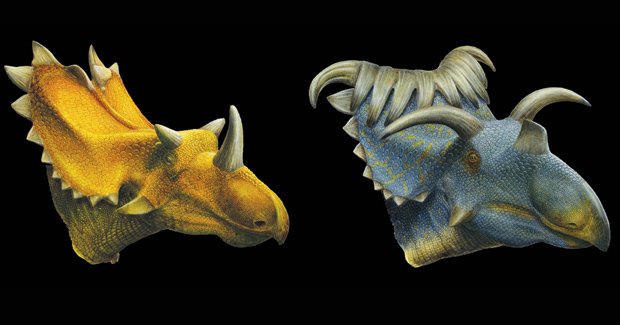15-horned dinosaur unearthed

ONE’S BEEN DESCRIBED AS pretty, with a dazzling array of 15 horns. The other’s been likened to a giant rhino with a supersized head. The average observer may not consider these new species of dinosaur great beauties, but to the scientists who unearthed them in southern Utah they’re very easy on the eye.
“These are really, really neat looking animals,” says James Cook University geologist Eric Roberts, who is helping reveal the secret lives of the 15-horned Kosmoceratops richardsoni and its larger mate Utahceratops gettyi. “The really remarkable thing is their skulls are so big.”
A study announcing the discovery of the new species has been published in the latest edition of PLoS ONE, an online journal produced by the Public Library of Science in the United States.
Eric, one of the study’s authors, says the giant plant-eaters were inhabitants of the lost continent of Laramidia, formed when a shallow sea split North America’s central region. Research has shown they roamed the region about 76 million years ago.
Most ornate dinosaur known
“Kosmoceratops richardsoni has 15 horns – one over the nose, one atop each eye, one at the tip of each cheek bone, and 10 across the rear margin of the bony frill – making it the most ornate-headed dinosaur known,” the Australian-based researcher says. Its name means “ornate horned face of Richardson,” in reference to the many horns on the skull of this animal and to Scott Richardson, who discovered many of its bones.
It was about 5 m long and weighed about 2.5 tonnes. Utahceratops gettyi, whose name means “Utah horned face of Getty”, was even bigger, at 6 – 7 m long, 2 m tall and 3 – 4 tonnes. It also had a whopping head, with its skull measuring about 2.3 metres in length and was adorned with a large horn over the nose and short and blunt eye horns projecting to the side.
Utahceratops and Kosmoceratops both belong to a group of big-bodied horned dinosaurs called ceratopsids, and are close relatives of the more well-known triceratops.
Dinsaur discovery the “tip of the iceberg”
Eric says many more discoveries, including other new species of dinosaurs, would be announced in coming months and years from southern Utah’s fossil goldmine. “What’s being published this week is just the tip of the iceberg,” he says. “There’s a lifetime of science to be done at this site,” Eric says.
“We’ve only been working on this project for about 10 years now. If you compare this site to other famous fossil locations we expect to eclipse those. The world will hear about new species of dinosaurs, plants and invertebrates,” he says. Not bad for a strip of Utah that’s only about 50km long and between three and five kilometres wide.
Project leader Scott Sampson, from the Utah Museum of Natural History and the University of Utah, began focusing on the area in 2000 after fossil fragments were sporadically found in the area. When he and a colleague made their first trip there, they found an abundance of fossils, including ones new to science.
VIDEO: Scientist Dr Scott Sampson talks about the new horned dinosaur discoveries.
RELATED STORIES

